The AMD Ryzen 5 2500X and Ryzen 3 2300X CPU Review
by Ian Cutress on February 11, 2019 11:45 AM ESTGaming: Ashes Classic (DX12)
Seen as the holy child of DirectX12, Ashes of the Singularity (AoTS, or just Ashes) has been the first title to actively go explore as many of the DirectX12 features as it possibly can. Stardock, the developer behind the Nitrous engine which powers the game, has ensured that the real-time strategy title takes advantage of multiple cores and multiple graphics cards, in as many configurations as possible.
As a real-time strategy title, Ashes is all about responsiveness during both wide open shots but also concentrated battles. With DirectX12 at the helm, the ability to implement more draw calls per second allows the engine to work with substantial unit depth and effects that other RTS titles had to rely on combined draw calls to achieve, making some combined unit structures ultimately very rigid.
Stardock clearly understand the importance of an in-game benchmark, ensuring that such a tool was available and capable from day one, especially with all the additional DX12 features used and being able to characterize how they affected the title for the developer was important. The in-game benchmark performs a four minute fixed seed battle environment with a variety of shots, and outputs a vast amount of data to analyze.
For our benchmark, we run Ashes Classic: an older version of the game before the Escalation update. The reason for this is that this is easier to automate, without a splash screen, but still has a strong visual fidelity to test.
| AnandTech CPU Gaming 2019 Game List | ||||||||
| Game | Genre | Release Date | API | IGP | Low | Med | High | |
| Ashes: Classic | RTS | Mar 2016 |
DX12 | 720p Standard |
1080p Standard |
1440p Standard |
4K Standard |
|
Ashes has dropdown options for MSAA, Light Quality, Object Quality, Shading Samples, Shadow Quality, Textures, and separate options for the terrain. There are several presents, from Very Low to Extreme: we run our benchmarks at the above settings, and take the frame-time output for our average and percentile numbers.
All of our benchmark results can also be found in our benchmark engine, Bench.
| AnandTech | IGP | Low | Medium | High |
| Average FPS | 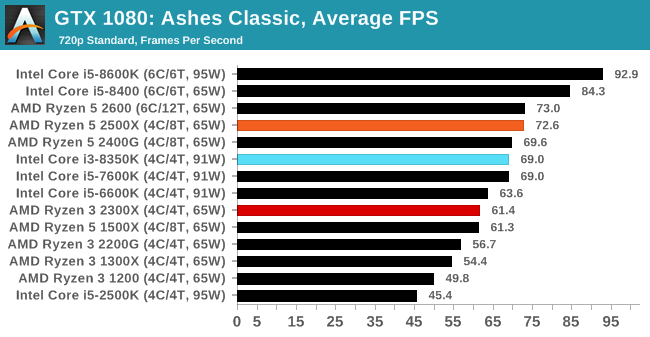 |
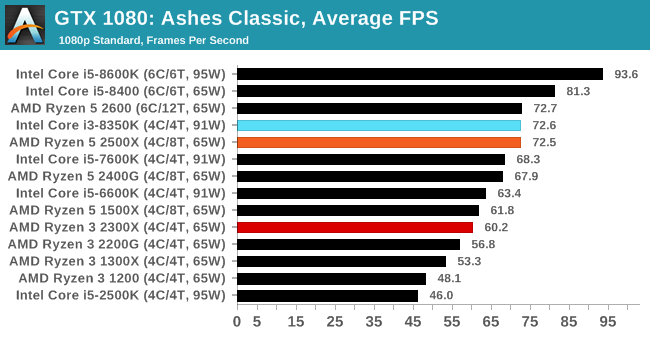 |
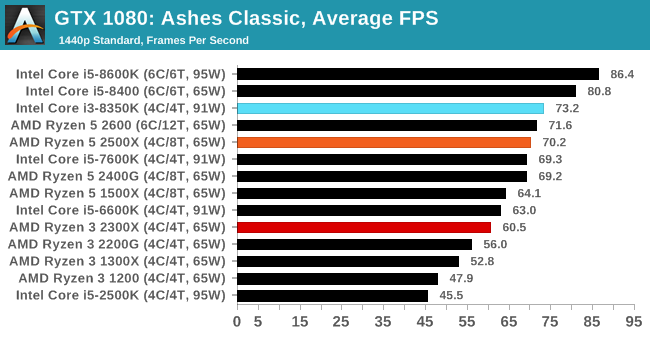 |
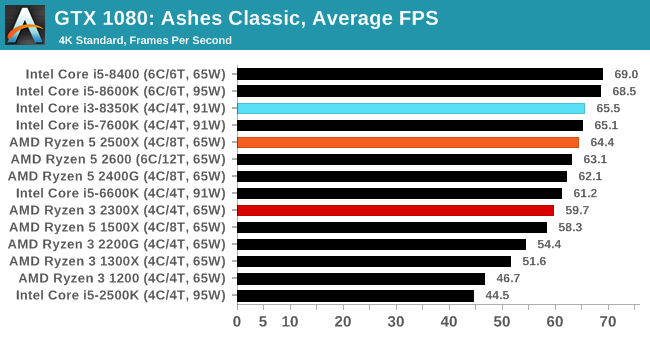 |
| 95th Percentile | 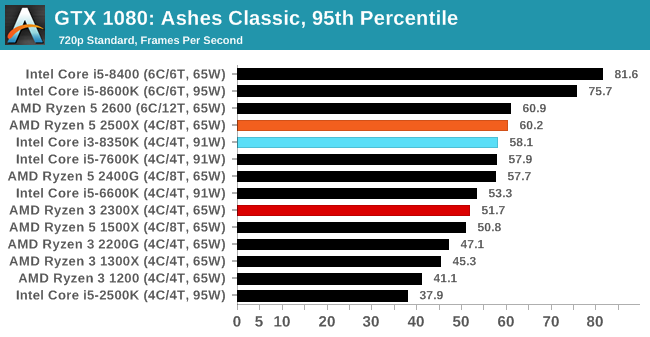 |
 |
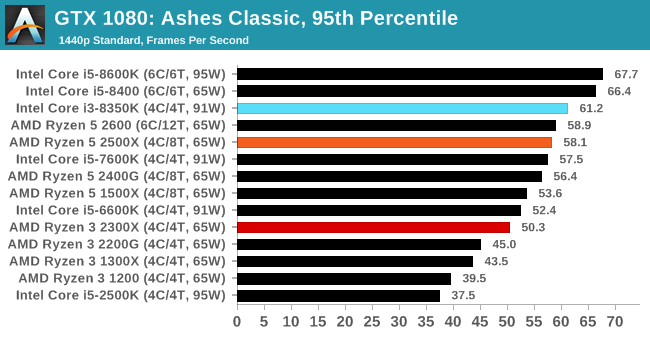 |
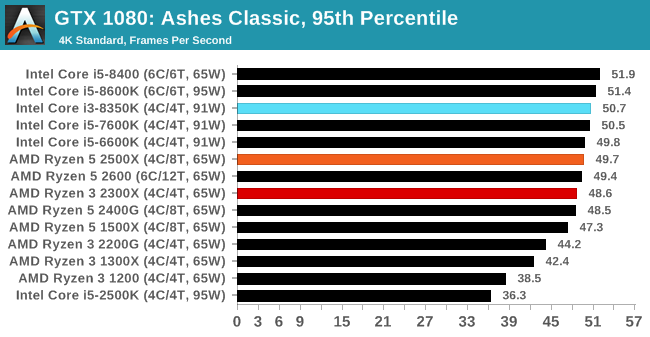 |
At the lowest resolutions, the 2500X has the high ground, but cedes it to the 8350K as the resolution ramps up.


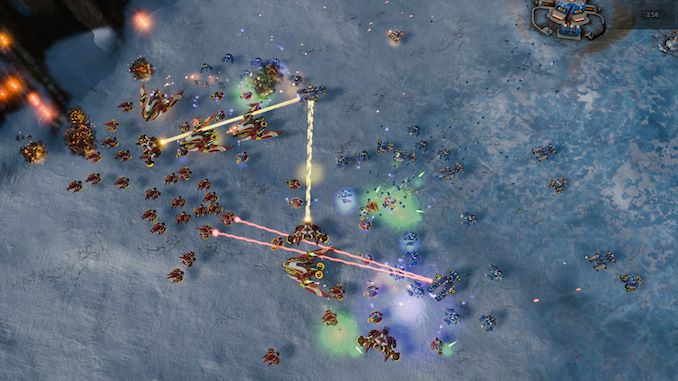









65 Comments
View All Comments
Daeros - Monday, February 11, 2019 - link
Your Intel bias is showing again, Ian. You've pitted a very nice selection of midrange processors from AMD against some very nice, almost double the price chips from Intel. If you're going to include the i5-8400 and i5-8600k, why not the R7 2600x or 2700? They're price-point competitors. But then, Intel wouldn't be at the top of the charts in almost any of the tests, would they?Ian Cutress - Monday, February 11, 2019 - link
All the data is in Bench for those parts. I mention repeatedly (as I did in our buyer's guide) that Intel doesn't really have anything competitive from 8th/9th Gen in the $120-$200 range. I put some parts in that are at least offer thread parity, as explained on page one of this review, if you read that far. But then again, Intel's 8th gen chips are priced well above the usual price right now.Subsequently, your data bias is showing. It's not about being at the absolute top of the graph. It never has. It's about competing with what's around you and some context either side from major competitors. If you want to compare higher priced parts against higher priced parts, then there's either a benchmark database to look at, or the corresponding reviews for those chips.
All quite apart from which, most of my analysis is comparing the AMD parts to other AMD parts because they're not sold at retail and where they would fit in if they did. That's one of the major points of this review.
c4v3man - Monday, February 11, 2019 - link
Is Anandtech trying to acquire an Intel i3-8100 processor for testing? This would seem to be a fairly natural comparison point to these processors at it's $117 customer pricing level. Granted you can approximate the results off the i3-8350K, and assume it's roughly 10% slower, but having actual numbers would be preferred over manual re-calculations.HStewart - Monday, February 11, 2019 - link
What about i5-8400T - according to ARC it price at $179 which will be in price range you statedhttps://www.intel.com/content/www/us/en/products/p...
Big difference is that it does not have Hyperthreading, been 6 cores without hyperthreading it could be serious competitor to Ryzen 5 2500X - it does have lesser max frequency than normal 8400
Korguz - Tuesday, February 12, 2019 - link
HStewart...that price.. could be an intel suggested price, or the tray price....
HStewart - Tuesday, February 12, 2019 - link
It is the price on Amazon, and selling outhttps://www.amazon.com/Intel-CM8068403358913-Core-...
MattMe - Tuesday, February 12, 2019 - link
@Ian - Whilst not quite as militant as some other forum users, I do agree that the testing and comparisons you have used here are not the most appropriate or useful. A similarly priced Intel CPU like the i3 would demonstrate competitive value in the marketplace. If we are including the more expensive Intel CPUs (because of their similar thread count, which I understand) then the graphs should have the equivalently priced AMD alternatives, again to help consumers understand the value proposition from both sides.Regarding the games/GPU options, I feel the testing you have carried out is useful, and although it's unlikely these CPUs would be paired with such a high-end GPU, we are at least ruling out the GPU being the limiting factor until reaching 4k, where your graphs demonstrate that the CPU is no longer the bottleneck. Without doubling the number of tests and data presented in the articles, I feel you've presented the most useful benchmarks and information. You'll never please everyone, I suppose.
Overall I think this is another fantastic write-up and appreciate the effort you put into the research and testing, but I can understand some people's frustrations when it comes to the comparisons you have chosen to demonstrate.
mikato - Thursday, April 4, 2019 - link
Well said"If we are including the more expensive Intel CPUs (because of their similar thread count, which I understand) then the graphs should have the equivalently priced AMD alternatives, again to help consumers understand the value proposition from both sides."
Phynaz - Monday, February 11, 2019 - link
Typical AMD - Hot and SlowformulaLS - Monday, February 11, 2019 - link
Typical Phynaz, quit the forums and said he won't be coming back and ended up flat out lying about it. Grow up dude.